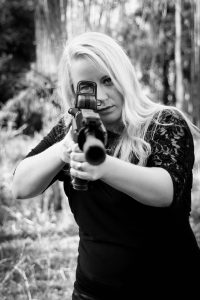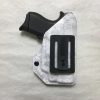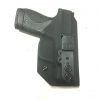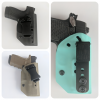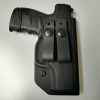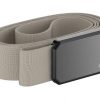You have three basic categories to choose from when it comes to home defense with a firearm: handgun, rifle, or shotgun. Of course, there are a lot of factors involved in making this decision including but not limited to cost, training, size, capacity, and ballistics. Each type of firearm has pros and cons which can change in relation to the particular defensive scenario you have in mind. Many would argue that a three-gun combination is best. Here is a brief overview of some things you should consider as you make your choices.
One of the biggest advantages of a handgun is its small size. A pistol can be easily stored in a small safe next to your bed or multiple safes can be stashed in key places around the home for quick access. Small size makes them easily handled in close quarters situations like hallways. Cost is another plus, with police & military quality handguns available for $500 and many other good options for less. Many full size pistols are capable of holding 15+ rounds of ammunition so you will have plenty to fend off even the most persistent of intruders.
On the negative side, a pistol is the least powerful of the three choices, representing only about a quarter of the power of a shotgun and a third of the power of a standard AR-15. Also, the short sight radius and hand-held nature makes it the most difficult to be accurate under stress. Many modern accessories like lasers and small red-dot sights can help mitigate these negative factors.
Of course there are many rifle choices available, but for this discussion we’ll consider the most popular sporting rifle today – the AR-15 – as it makes a great home defense gun. The long sight radius and the ability to shoulder the rifle – and adjust the stock length for different size shooters – is a major plus and increases accuracy under stress. Add in a reliable red-dot sight or variable power scope and it is pretty easy to put as many as 30 shots (in most states) on target very quickly. High velocity rifle rounds do a lot of damage and will stop a threat in short order.
A long gun’s extended sight radius is an advantage for accuracy, but can impede your movement in a close quarters situation. Of course, rifles can be modified shorter at significant cost for a new barrel and ATF tax stamp. Given the fact that lower end AR-15s start in the $6-700 range in the first place, adding accessories and/or making it shorter can push the overall cost up beyond $1500 pretty quick, making it the most expensive of the three choices.
Shotguns offer the same long sight radius and shouldered stability as a rifle and are usually very simple to operate. Twelve and twenty gauge shotguns both offer great power as well as affordability. Name brand youth models can be found for around $300, making a shotgun a good budget choice for home defense.
Although inexpensive and durable, shotguns have a few key disadvantages as well. Unless you spend more on a “tactical” version, most shotguns will only hold 4 or 5 shells and are the most difficult to reload under stress. And although these long guns are stable, they are not simply point and spray as some tend to believe. Keeping the sights on target while managing the hefty recoil (and loud noise – especially indoors!) of a twelve gauge is not an easy task for beginners.
Ammunition
One factor common to all three choices is ammunition type, availability and cost. Do a bit of research to understand the basics of ballistics and the differences between handgun, rifle, and shotgun ammunition. You will find that there are numerous types of ammunition available for each type and caliber of gun. The cost varies considerably depending on bullet type (ex: hollow-point vs. ball), powder weight (ex: 115 grain vs. 147 grain), casing material (ex: brass vs. aluminum), primer (ex: standard vs. lead-free), and on and on and on…. One important factor to consider in home defense is over-penetration – when bullets go through walls/doors/windows, etc. Always be sure of your target and what is beyond and know the likely penetration characteristics of your particular gun and ammunition combination.
Training
Another common aspect to consider is how much time and money you can budget for ongoing training. Handguns, while difficult to master, might be the least intimidating and most affordable to toss in a range bag and get started with at your local indoor range. Training properly to move and shoot with rifles and shotguns is not difficult but will require more investment in quality instruction which may not be offered at the local indoor range. You will need to decide how much time and money you want to spend on training (and ammunition) to keep your skills at the ready.
Playing Favorites
One approach we recommend is to try out each of your options first, possibly with a friend or find a range that will rent you a gun. You will probably find out that you enjoy and prefer one over the others. If you enjoy the gun you are shooting, you are more likely to get to the range to practice and your chances of surviving a defensive encounter are much higher. Any gun that sits in the safe and collects dust because you do not enjoy shooting it or because the ammo/range/instruction makes it too expensive/difficult to shoot is simply not a good primary defensive weapon choice for you. Play your favorite and have fun!


